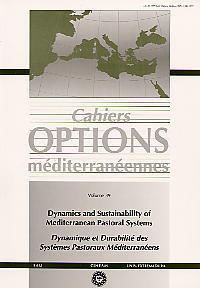| Article précédent | p. 283-285 | Article suivant |
Prospecting and evaluation in degraded areas, of annual forage legumes, fodder shrubs and perennial grasses typical from Extremadura
Once the most important areas have been determined on the Map of Erosive States of the Guadiana and Tajo hydrographic basin, a prospecting of three areas was carried out which correspond to different climatic and soil conditions. The best points for harvesting the seeds were determined in impoverished areas or with low soil potential. The hypothesis is that the plants that grow in these places with degraded soil are resistant to the environmental stress that takes place in the areas that have to be replanted. Three groups of local species were harvested: 1) annual forage legumes; 2) fodder shrubs; 3) perennial grasses. A first evaluation of the whole material harvested has been done, with the aim of selecting by areas the most productive and persistent ecotypes.
- [ Afficher ]
- [ Télécharger ]
- [ Exporter la citation ]
Vous pouvez télécharger la citation au format :
- [ Imprimer ]
-
Mots-clés
ESPAGNE, GRAMINEE, LEGUMINEUSE FOURRAGERE, PLANTE ANNUELLE, PLANTE PERENNECiter cet article
González F., Moreno V., Paredes J., Prieto P.M., Paniagua M. Prospecting and evaluation in degraded areas, of annual forage legumes, fodder shrubs and perennial grasses typical from Extremadura. In : Etienne M. (ed.). Dynamics and sustainability of Mediterranean pastoral systems . Zaragoza : CIHEAM, 1999. p. 283-285. (Cahiers Options Méditerranéennes; n. 39). 9. Meeting of the Mediterranean Sub-Network of the FAO-CIHEAM Inter-Regional Cooperative Research and Development Network on Pastures and Fodder Crops, 1997/11/26-29, Badajoz (Spain). http://om.ciheam.org/om/pdf/c39/99600089.pdf



